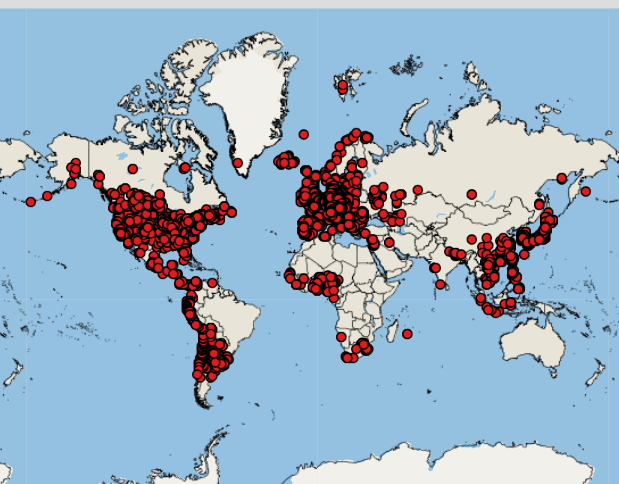Public health situation for avian influenza A(H5) viruses
Epidemiological background in humans
Sporadic human cases of different avian influenza virus A(H5Nx) subtypes have been reported globally, which are included in the monthly Communicable disease threats reports and Annual epidemiological reports.
Based on the data available from the EpiFlu database of the Global Initiative on Sharing All Influenza Data (GISAID), since 2020, human infections have been caused by four different A(H5) clades of the A/goose/Guangdong/1/1996 lineage, namely, 2.3.2.1c (Laos, 2020 and Cambodia, 2023), 2.3.2.1a (India, 2021), 2.3.4.4h (China, 2020–2021), and 2.3.4.4b (China, 2020; Europe, 2020; North and South America, 2022).
Human infections with A(H5N1) and A(H5N6) have shown a high level of severity related to viruses with varying genetic compositions e.g. in Cambodia, China, Chile, or Ecuador. The contributing viral factors, host or environmental conditions leading to severe illness in humans are not fully understood.
Despite the high number of exposure events due to the large outbreaks in poultry and wild birds since 2020, no symptomatic human infection due to avian influenza A(H5Nx) has been reported from EU/EEA countries. In Spain, two detections of viral RNA of A(H5N1) in specimens from poultry workers involved in outbreak response and culling activities have been considered contaminations. Currently, avian influenza virus transmission to humans remains a rare event. Only sporadic human infections have been reported globally over the last few years, and no clusters with limited transmission between humans have been observed.
Viruses currently circulating in bird populations in Europe are considered to be avian-adapted viruses that bind to avian-like receptors and replicate best in birds. Due to the high number of dead wild birds and the related environmental contamination, wild terrestrial (carnivore) and marine mammals have also been in contact with avian influenza viruses through the consumption of sick or dead birds. This has resulted in the identification of an increasing number of different terrestrial and marine mammalian species as infected with A(H5N1) viruses. Viruses from these mammals carried markers for mammalian adaptation in genes, such as the polymerase basic protein 2 (PB2) gene that has been identified in studies to increase replication and virulence in mammals.
The recent severe human cases in Asia and South America in individuals exposed to infected sick and dead backyard poultry, dead wild animals or contaminated environments underline the risks associated with unprotected contact with avian influenza viruses. This is particularly pertinent in backyard settings where biosecurity measures are often insufficiently applied.
Ongoing local reassortment events, where an exchange of gene segments with local low pathogenic avian influenza viruses occurs, contribute to the already high genetic diversity of circulating avian influenza A(H5N1) viruses.
A study on circulating A(H5N1) viruses in North America showed that these viruses efficiently replicated in human respiratory tract cell types. Viruses carrying markers of mammalian adaptation, for e.g. PB2 E627K, can transmit between ferrets through direct contact.
With the high presence of avian influenza viruses in wild birds causing mass mortality events and outbreaks in poultry farms and backyard holdings, as well as spillover to mammalian species, humans will be continuously exposed to avian influenza viruses. Sporadic transmission events cannot be excluded when in direct and unprotected contact with infectious viruses.
Avian influenza situation in birds and mammals
Large outbreaks due to highly pathogenic avian influenza (HPAI) virus A(H5Nx) in wild birds and poultry have been reported in Europe since autumn 2020 – the virus subtypes A(H5N8) dominating from 2014–2021, and A(H5N1) since mid-2021. These are described in the joint quarterly situation overview reports by the European Food Safety Authority (EFSA), ECDC and the European Union Reference Laboratory for Avian influenza (EURL). Spillover from infected wild birds to commercial farms has resulted in great losses in the poultry sector with roughly 100 million dead or culled poultry since 2020.
During the outbreaks in Europe, many different wild bird species have been affected by mass-mortality events observed in sea-breeding colony birds since summer 2022.
Avian influenza A(H5N1) viruses from Europe were introduced to North America in spring 2022 through migratory birds and spread rapidly across Canada and the US. A further rapid spread was observed across countries in Central and South America with the autumnal bird migration. Only Australia and Antarctica as continents have not been affected to date.

Transmission of highly pathogenic avian influenza A(H5N1) viruses to various terrestrial mammalian species, mainly carnivores, such as foxes, as well as marine mammals have been reported from many countries worldwide as described in the latest joint EFSA/ECDC/EURL situation report on avian influenza viruses. Mass mortality events with possible mammal-to-mammal transmission have been reported in a mink farm, sea lions in Chile and Ecuador, and seals in the US coast. An A(H5N1) outbreak in a mink farm in October 2022 in northwest Spain suggested mammal-to-mammal transmission (Aguero et al., 2023). Viruses from these infected animals carried markers for mammalian adaptation, such as in the PB2 gene. The mutations found in this gene are associated with increased replication and virulence in mammals. However, no mutations in the receptor binding hemagglutinin (HA) protein have been identified that would switch the binding preference of the viruses from avian-like to human-like receptors.
European Union legislation regarding the use of vaccines against avian influenza viruses in birds or poultry production or other sectors became active in May 2023 in the Commission delegated regulation (EU) 2023/361.
Up-to-date information about avian influenza outbreaks in birds is available in the following EFSA resources:
- Highly pathogenic avian influenza virus detection in Europe dashboard
- Migration Mapping Tool
- Bird Flu Radar, an early warning system of highly pathogenic avian influenza for the EU.
The World Organisation for Animal Health (WOAH) provides additional guidance for the animal-human interface dealing with avian influenza outbreaks.




